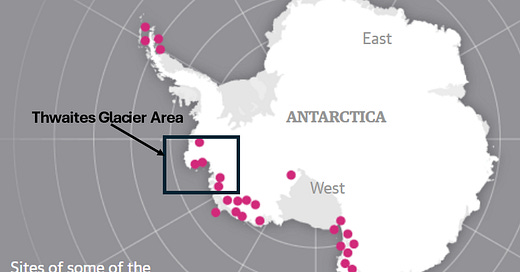What is Really Melting Thwaites Glacier?
The Overlooked Impact of Geothermal Heat on 'The Doomsday' Glacier Melting
Heat flow in the geologic sense refers to the movement of thermal energy from the interior of the Earth to its surface. This heat originates from two primary sources: the residual heat from the planet's formation and the heat produced by the radioactive decay of isotopes within the Earth's mantle and crust.
When Earth formed approximately 4.5 billion years ago, it was a hot, molten sphere. Over time, the planet began to cool and solidify, but a significant amount of this primordial heat is still retained within the Earth's interior. This residual heat continues to flow outward from the core towards the surface, contributing to the overall geothermal gradient.
Within the Earth's mantle and crust, certain isotopes undergo radioactive decay, a process that releases thermal energy. Key isotopes contributing to this process include uranium-238, thorium-232, and potassium-40. As these isotopes decay, they release heat, which is a significant source of the Earth's internal thermal energy. This radioactive decay is ongoing, providing a continuous supply of heat that helps drive various geological processes such as mantle convection, plate tectonics, and volcanic activity.
On average, the heat flow from the Earth's interior is around 70 milliwatts per square meter (mW/m²) across the continents and about 105 mW/m² across the ocean basins. However, these average values mask significant variations influenced by geological features and tectonic activity.
In areas with high tectonic activity, such as mid-ocean ridges and volcanic regions, heat flow can be considerably higher. For example, mid-ocean ridges, where tectonic plates are diverging, allow hot mantle material to rise closer to the Earth's surface, resulting in heat flow values that can exceed 200 mW/m². Similarly, volcanic regions exhibit elevated heat flow due to the presence of magma near the surface.
Conversely, older and more stable regions, such as continental cratons, tend to have lower heat flow values. Cratons are ancient and stable parts of the continental lithosphere that have cooled significantly over geological time. In these regions, heat flow values can be as low as 30-40 mW/m² due to the thick, insulating lithospheric mantle that limits the upward movement of heat.
Geological structures such as sedimentary basins, mountain ranges, and fault zones also contribute to the variability in heat flow. Sedimentary basins, which often contain thick sequences of insulating sediments, can have lower heat flow compared to surrounding areas. In contrast, mountain ranges, formed by tectonic compression and uplift, can have higher heat flow due to the presence of radioactive minerals and the relatively thin lithosphere.
This variability in heat flow is crucial for understanding the thermal structure of the Earth's crust and mantle, as well as for applications such as geothermal energy exploration, tectonic studies, and the assessment of thermal regimes in different geological settings.
With the recent discovery of many more volcanoes under Western Antarctica surely studies examining the melting of the so-called ‘Doomsday’ Glacier would consider heat flow.

One recent study published in Nature Communications presents findings that challenge the common narrative that GHGs are responsible for melting in Western Antarctica, particularly under the Thwaites Glacier. The study reports heat flux values exceeding 110 mW/m² beneath the glacier, which is significantly higher than the global averages for continents. This high heat flux is likely contributing to the melting of the Thwaites Glacier, an aspect often overlooked in discussions focusing solely on atmospheric warming.
The figure below from the Nature Communications study illustrates the spatial variability in geothermal heat flux under the Thwaites Glacier, showing values well over 110 mW/m² in some regions. This high geothermal heat flux is a critical factor in the observed melting patterns and dynamics of the glacier. However, this aspect is often ignored or downplayed in broader climate narratives.
Keep reading with a 7-day free trial
Subscribe to Irrational Fear to keep reading this post and get 7 days of free access to the full post archives.



